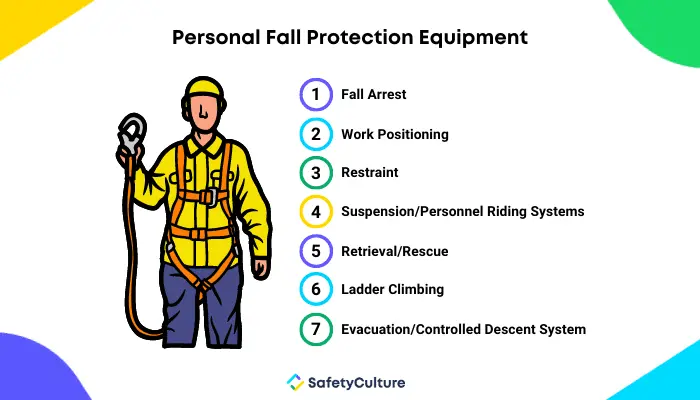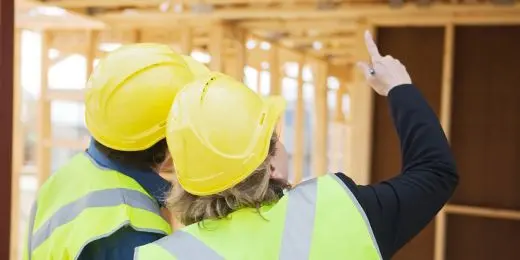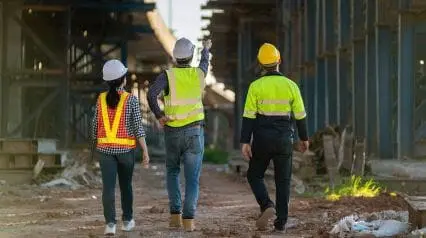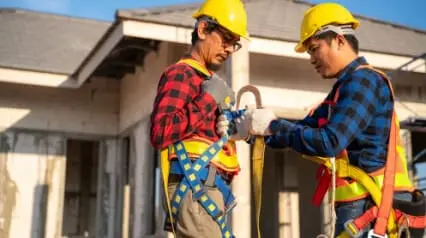What is Fall Protection?
Fall protection is equipment used to prevent individuals from falling from elevated surfaces or when working at heights. Fall protection is composed of different types of safety harnesses and protection systems, including fall arrest, work positioning, restraint, suspension, retreival, ladder climbing, and controlled descent systems, among others. It is typically used in high-risk industries such as construction, maintenance, and manufacturing.
Why is Fall Protection Safety Important?
Fall protection safety should be a top priority when working on tasks that require harnesses. Performing regular worksite and safety harness inspections can help prevent fatal falls and accidents. Site safety inspections should ensure permits, installation, training, and overall equipment are in place. Harnesses and lanyards should always be inspected before use to determine if the equipment is in a safe condition.
7 Types of Personal Fall Protection Equipment
Employers must ensure that the following personal fall protection system and safety harnesses are used to comply with OSHA’s standard 1910.140:
Fall Arrest
A fall arrest system should be used when working at an elevated level and when exposed to a fall hazard. This fall protection equipment gives personnel freedom of movement. It allows them to reach a point where a fall can occur where it safely stops a person from hitting the ground.
| Anchorage: | Support structure capable of supporting 5,000lb per employee attached. Should be supervised by a qualified person. |
| Anchorage Connector: | Anchor sling, I-beam trolley, or other |
| Body Support: | Full body harness |
| Connecting Means: | Lanyard, deceleration device, lifeline, fall arrester or a suitable combination of these |
Work Positioning
A work positioning system holds a worker in place, allowing them to work hands-free at elevated vertical surfaces such as walls or window sill.
| Anchorage: | Ladder or vertical rods |
| Body Support: | Full body harness or body belt |
| Connecting Means: | Anchor bolt, trolley, carabiner or rebar assembly |
Restraint
A restraint allows workers to reach the work surface safely thus avoiding reaching a location from which a fall hazard exists.
| Anchorage: | Support structure |
| Anchorage Connector: | Anchor sling and roof anchor system |
| Body Support: | Full body harness or body belt |
| Connecting Means: | Positioning lanyard |
Suspension/Personnel Riding Systems
Suspension systems are designed to lower and support a worker to move vertically allowing a hands-free work environment. This is commonly used in the industry when doing paint work and window washing.
| Anchorage: | Support structure |
| Anchorage Connector: | Anchor sling, tripod or dacit |
| Body Support: | Full body harness |
| Connecting Means: | Vertical lifeline ascender/descender and backup vertical lifeline with rope grab |
Retrieval/Rescue
A retrieval system or rescue system is used primarily for when working in confined spaces. It is designed to support a worker when entering tanks, manholes, etc. Should an emergency occur, it is used to retrieve the worker from above.
| Anchorage: | Support structure |
| Anchorage Connector: | Tripod or davit |
| Body Support: | Full body harness |
| Connecting Means: | Self-retracting lifeline and a personnel rated hoist should a ladder be unavailable or cannot be accessed |
Ladder Climbing
A ladder safety system should be in place to eliminate or reduce the possibility of falling off when climbing or descending from a ladder.
For permanent fixed ladders:
| Anchorage: | Permanent ladder meeting OSHA’s requirements |
| Anchorage Connector: | Fixed wire rope lifeline and a mobile fall arrester |
| Body Support: | Full body harness |
| Connecting Means: | Locking carabiner, fall arrester, and body support harness |
For temporary, portable ladders:
| Anchorage: | Overhead structural member of suitable size, shape, and strength |
| Anchorage Connector: | Vertical lifeline, synthetic rope or wire type, and mobile fall arrester |
| Body Support: | Full body harness |
| Connecting Means: | Lanyard |
Evacuation/Controlled Descent System
This is used when assisting a rescue via raising or lowering the rescue subject onto a safe working level. This is slightly different from a harness that can be used for ascent or descent because it is meant for very brief periods of use.
| Anchorage: | Support structure |
| Anchorage Connector: | Tie-off sling |
| Body Support: | Full body harness |
| Connecting Means: | Controlled descent device |
5 Safety Harness Inspection Safety Tips
Inspect the following for fall prevention.
-
Inspect labels and tags – Always check to ensure product labeling and tagging is legible and attached to the lanyard
-
Webbings and stitching – Webbing should be free from cuts, broken fibers, and other damage. Visually check for damage across the entire length of the equipment
-
Inspect all D-rings and metal parts – D-rings, buckles, rivets, and grommets should be free from cracks and deformities. Visually and physically check for sharp edges and distortions.
-
Inspect snap hook ends – Snap Hooks should have no hook and eye distortions. Check for evidence of corrosion or other damage.
-
Check lanyards – Lanyards should be able to carry standard bodyweight. Inspect rope lanyards for broken strands. Discard lanyards with broken strands.
Explore our Free Safety Harness Inspection Templates
See how digital checklists simplify business processes with just a tap.
View nowProtect Your Workers From Falls with SafetyCulture
Keep teams safe while they do their best work. SafetyCulture (formerly iAuditor) is a digital platform dedicated to driving safety, quality, and efficiency in the organization. It enables teams to digitize paper inspection forms and checklists so that teams are able to easily perform checks or inspections through a mobile or tablet device. SafetyCulture also allows you to train your employees on proper fall protection practices and gear, as well as gives you a platform to manage your assets.
Learn how to get started with SafetyCulture through our collection of 2-minute tutorials or check out this getting started guide.




